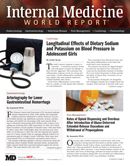Sodium Intake in Girls' Teen Years: No Effect on Blood Pressure
What's the story with salt? Dietary guidelines for adults – especially those who are older, black, have elevated blood pressures, diabetes or chronic kidney disease – recommend consuming less than 1500 mg daily.

What’s the story with salt? Dietary guidelines for adults — especially those who are older, black, have elevated blood pressures, diabetes or chronic kidney disease – recommend consuming less than 1500 mg daily.
Meanwhile, the remaining 50% of American adults are allowed to consume up to 2300 mg, but with salt present in almost everything, it’s more than a challenge, it’s an almost unsolvable puzzle for patients. And, in 2013 the Institute of Medicine declared that evidence to support the current sodium Dietary Guidelines for Americans is insufficient.
Further complicating the picture: salt intake in adolescents is almost uncharted water. The June 2015 issue of JAMA Pediatrics presented a study of sodium intake in adolescent girls. Its findings made us question all we presumed we knew about sodium intake and hypertension.
These researchers used data from the National Heart, Lung, and Blood Institute's Growth and Health Study, which followed 2,185 black and white girls initially aged 9 to 10 years for 10 years. One of its focuses was early-adolescent to mid-adolescent diet and blood pressure, and subsequently, good data on each is available.
This study assessed mean dietary sodium and potassium intakes and the mean potassium-to-sodium ratio in participants, and paid careful attention to confounding factors. The researchers sorted participants into several groups by level of sodium and potassium intakes.
Regardless of sodium intake, systolic or diastolic blood pressures were unaffected throughout adolescence and at the study’s end. This held true even for participants who consumed more than 4000 mg/day.
The researchers could find no indication that black or white girls who consumed the lowest amounts of sodium (<2500 mg/day) were at any advantage with respect to blood pressure.
Higher potassium, on the other hand, tended to be inversely associated with blood pressure. This relationship was especially true for systolic blood pressure in black girls.
These findings are noteworthy because the study’s 10-year duration was considerably longer than most studies that have attempted to define sodium’s role in blood pressure regulation in adolescents.
The researchers stressed that healthcare providers need methods for estimating salt sensitivity in high-risk populations and better information about the potential effects of low dietary potassium intakes among US children and adolescents.
